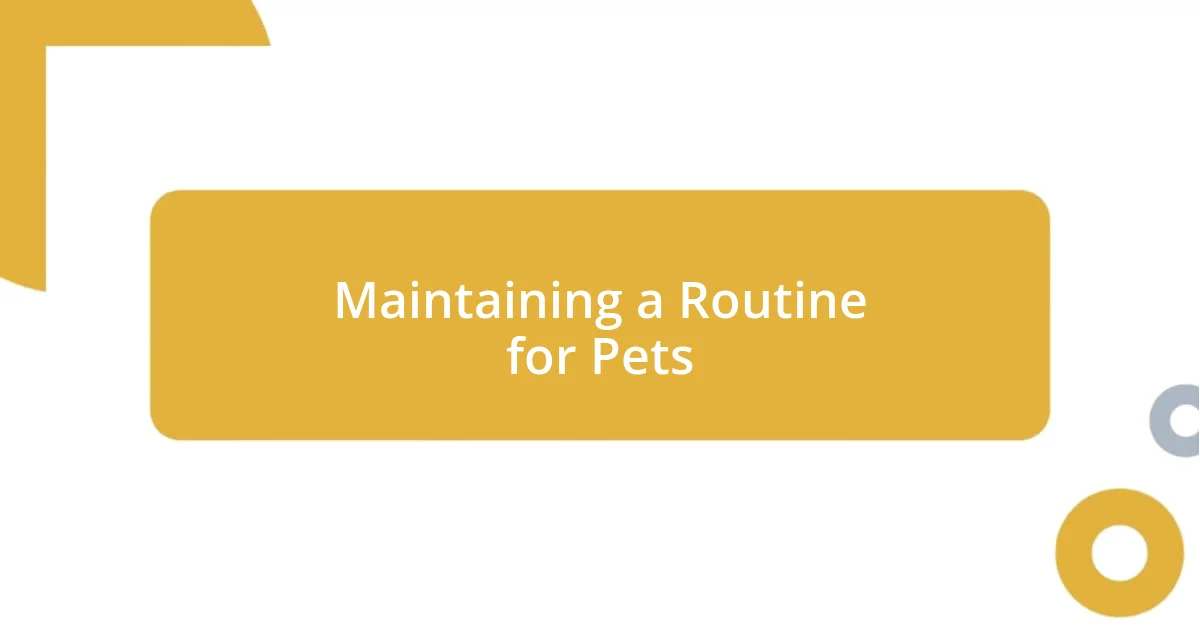Key takeaways:
- Understanding a pet’s unique comfort needs requires attention to their body language and individual preferences for a secure environment.
- Creating a cozy space involves using soft textures, safe corners, and familiar items to foster a sense of belonging and relaxation.
- Monitoring behavioral changes and seeking veterinary advice when necessary are crucial for ensuring pets’ health and well-being.

Understanding Pet Comfort Needs
Understanding a pet’s comfort needs goes beyond just providing food and shelter. For instance, I remember the first time I noticed my cat, Whiskers, seeking out the sunniest spot in the house. It struck me how simple yet crucial such preferences are. Isn’t it fascinating how our pets instinctively know what makes them feel cozy and secure?
Each pet has unique comfort requirements, shaped by their breed, age, and personality. I’ve often found that my elder dog, Max, prefers softer resting places, perhaps reflecting his arthritis. Have you ever considered how your pet’s background influences their comfort levels? A rescue animal, for example, might require additional reassurance to feel secure in their new environment.
To truly understand what makes our furry friends comfortable, we need to tune into their body language and vocalizations. When I see my dog wagging his tail and burying his nose into his bed, I know he’s in his happy place. It makes me wonder—how often do we miss these subtle cues? Recognizing these signs can deepen our relationship with them and enhance their overall well-being.

Creating a Cozy Environment
Creating a cozy environment for pets is crucial for their well-being. When I rearranged my living room to include plush blankets and low-slung furniture, I noticed my dog, Bella, immediately found her favorite snoozing spot. It’s amazing how a simple shift in space can make them feel more secure and at home.
I’ve learned that textures play a significant role in this process. For example, I discovered that our cats snuggle more when we use soft, fluffy beds rather than flat, hard surfaces. Just last week, I bought a new bed made of faux fur, and you wouldn’t believe how quickly both Jasper and Luna claimed it as their domain. Have you ever observed how certain fabrics seem to invite your pets in for a cuddle?
Creating a cozy atmosphere isn’t just about physical comfort; it also involves a sense of safety. I remember giving my timid rescue cat, Mabel, a quiet corner of the house filled with her favorite toys and a snug blanket. The transformation in her demeanor was profound. She felt at ease and began exploring, reminding me how vital it is for pets to have a sanctuary that feels like their own.
| Elements | Details |
|---|---|
| Textures | Soft materials like faux fur can enhance comfort levels |
| Safe Spaces | Quiet corners allow pets to retreat and feel secure |
| Warmth | Providing blankets helps pets feel cozy |
| Familiar Items | Using toys and belongings can create a sense of belonging |

Choosing the Right Bedding
When it comes to choosing the right bedding for pets, I’ve found that comfort can significantly impact their happiness and rest. A few months ago, I decided to replace Max’s old bed with a more supportive orthopedic option. The change was remarkable; he curled up with a blissful sigh, clearly enjoying the better support for his aging joints. It reinforced my belief that the right bedding can make a world of difference, especially for senior or special-needs pets.
Here are some considerations I always keep in mind when selecting bedding:
- Size: Ensure the bed accommodates your pet’s size comfortably, allowing them to stretch out without feeling cramped.
- Material: Opt for washable and durable materials; pets can be messy, and I’ve learned the hard way to avoid overly delicate fabrics.
- Support: Choose beds that provide adequate support, like memory foam or orthopedic styles, particularly for older pets with joint issues.
- Temperature Sensitivity: Some pets dislike cold surfaces; I often place heated pads under the bedding during colder months for extra warmth.
- Accessibility: For pets with mobility struggles, select beds that offer low edges or even ramp access to help them get in and out easily.
Finding the right bedding can feel like a personal journey, often requiring trial and error. I recall a time when I bought a fancy bed adorned with attractive designs, only to find Bella snubbing it for a simple old blanket. Sometimes, it’s really about meeting their individual tastes, which might not align with what we envision as “perfect.” Listening to their preferences can be such an enlightening experience!

Incorporating Calming Accessories
Incorporating calming accessories into your pet’s environment can truly enhance their sense of peace. I remember the first time I introduced calming pheromone diffusers into our home; it felt like a game changer. When I plugged one in, I saw immediately how it seemed to soothe Bella, who often got anxious during thunderstorms. It’s fascinating how these little bottles can mimic the natural scents that reassure pets, almost like a fragrant hug in the air.
I’ve also had great success with weighted blankets for my anxious fur babies. When I draped a lightweight one over Max during fireworks season, I noticed he nestled right into it, finding comfort and security. It’s intriguing how something as simple as weight can provide a comforting presence for pets, much like how we feel cozier under a heavy blanket. Have you tried it with your pets? Sometimes, these accessories serve as a gentle reminder that they’re not alone in stressful situations.
Another favorite accessory of mine is calming music specifically designed for pets. I was skeptical at first, but on days when my cats seemed restless, I played some soft melodies. The change in their behavior was almost immediate; they would curl up and start to purr in bliss. It’s amazing how sound can influence mood in our pets, and it has become a delightful part of our daily routine. It’s worth exploring these calming tools to see how they can transform your pet’s emotional landscape!

Maintaining a Routine for Pets
Maintaining a consistent routine for my pets has been a game changer in ensuring their comfort and well-being. I remember a time when I decided to feed Max and Bella at the same time each day. Not only did this simplify my schedule, but I also noticed they became more relaxed and less anxious, anticipating mealtime with wagging tails and soft purrs. Isn’t it interesting how something so simple can create a sense of stability in their lives?
When it comes to exercise, I’ve made it a priority to take Max for walks at the same time every day. I’ve learned that this routine not only keeps him healthy but also helps him feel secure. Dogs thrive on predictability, and I’ve seen how his energy levels spike on days when our walk times fluctuate. Have you ever felt that rhythm with your pets? I highly recommend establishing these patterns; it can be so rewarding to witness the positive impact on their mood.
Even simple rituals like playtime or grooming can provide a comforting structure for pets. There’s something deeply satisfying about brushing Bella right before bedtime; she snuggles in closer afterward as if the routine has made her feel safe. This shared moment strengthens our bond, and it’s truly heartwarming. Creating these small, consistent rituals not only comforts them but enriches our time together, fostering a nurturing environment.

Monitoring Pet Behavior Changes
Monitoring changes in my pets’ behavior has become an essential part of ensuring their well-being. I recall a time when Bella seemed unusually withdrawn; she wasn’t her usual playful self. After a few days of observing her subtle changes—like less interest in her toys and more time spent hiding—I knew it was time to consult with the vet. It’s remarkable how being attuned to their behaviors can lead to early detection of potential issues, don’t you think?
I’ve also found that keeping a journal of my pets’ moods and actions can be incredibly insightful. For example, I once noted that Max was more anxious during certain parts of the day. By correlating these behaviors with specific triggers, like the noisy construction outside, I learned to manage his environment better. It’s like a puzzle where each piece informs the whole picture, offering a unique glimpse into their emotional landscape. Have you tried a similar approach with your pets?
Tracking behaviors like eating habits, playfulness, or even sleeping patterns can signal a lot about their comfort levels. I remember a phase where Bella suddenly stopped finishing her meals; it worried me. By monitoring her closely, I discovered it was simply a picky phase rather than a health issue. Engaging in this kind of observation not only helps you understand your pet’s needs better but also fosters a deeper bond, as they feel your attentiveness and care.

Seeking Veterinary Advice When Needed
There have been moments when I’ve realized that consulting a veterinarian is crucial for my pets’ wellness. For instance, when Max developed a persistent cough, I felt a wave of concern wash over me. I initially hoped it was just a fleeting issue, but deep down, I knew I had to seek professional advice. Taking him to the vet brought immense relief, both for me and for him, as it turned out to be a minor condition that was easily treatable.
Sometimes, the signs aren’t always obvious, and that’s when I remind myself to rely on my vet’s expertise. I vividly recall a time when I had questions about Bella’s dietary needs after she showed signs of discomfort. A quick phone call with our vet not only provided clarity but also reassured me that I was doing the right thing for her health. Have you ever felt that mix of confusion and worry about your pet’s well-being? I certainly have, and reaching out for help can be just what you need to ease your mind.
It’s essential not to underestimate the value of veterinary advice. After all, they have the knowledge and training to spot issues that might go unnoticed. I remember asking my vet about Max’s sudden fear of thunderstorms; he suggested calming techniques that I hadn’t considered. Implementing those tips made a significant difference in his comfort during storms. This experience taught me that there’s no shame in asking for help—it’s a vital step in providing the best care possible for our furry family members.












